Spain...a day in the life....
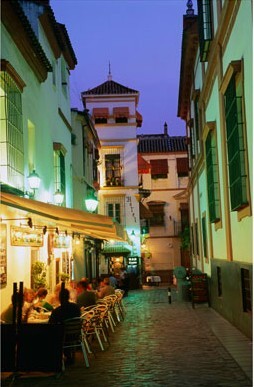 Written & compiled By Louis S. Luzzo, Sr.
Written & compiled By Louis S. Luzzo, Sr.
The inspiration for my wanting to write this article was a conversation I had recently with Arturo Sandoval. Though he is from Cuba, like a good number of Latin Americans, some of his ancestors are from Spain. He was explaining about his grandfather and mother, describing for us what is the the typical Spanish day, especially as it pertains to lifestyle and how the people of Spain incorporate food and the famed 'siesta' into their daily routine.
As Arturo spoke, it was a fascinating glimpse of this vibrant country's people, culture and lifestyle. Admittedly, the appeal and allure of this laid back pace, that 'smooth glide through life,' as I have come to refer to it, was just too good to pass up, so here we find ourselves this month whisking off to Spain for a look at 'a day in the life.'
For me, the observance of what is the Spanish dining ritual, if you will allow, is such a wonderful way to socialize and spend quality time with the ones you love, enjoying the varying nuances of every part of the day, from sunrise and breakfast, all the way through to churros and hot chocolate at 2 A.M. In Spain, every day is a celebration unto itself, deserving of your 100 % effort, an embracing of a lifestyle that is very much after my own heart; Squeezing every drop of life out of every minute of every day.... so as not to miss a moment. A pretty intense, and possibly quite exhausting way to live, hence... the Siesta! Spain is a country set in traditions, especially when it comes to the subject of food, so before we delve into the specifics, we need to a quick trip through the basics of Spain's cultural and culinary history, in order to give us a better understanding of the region and its people.
The Iberian Peninsula
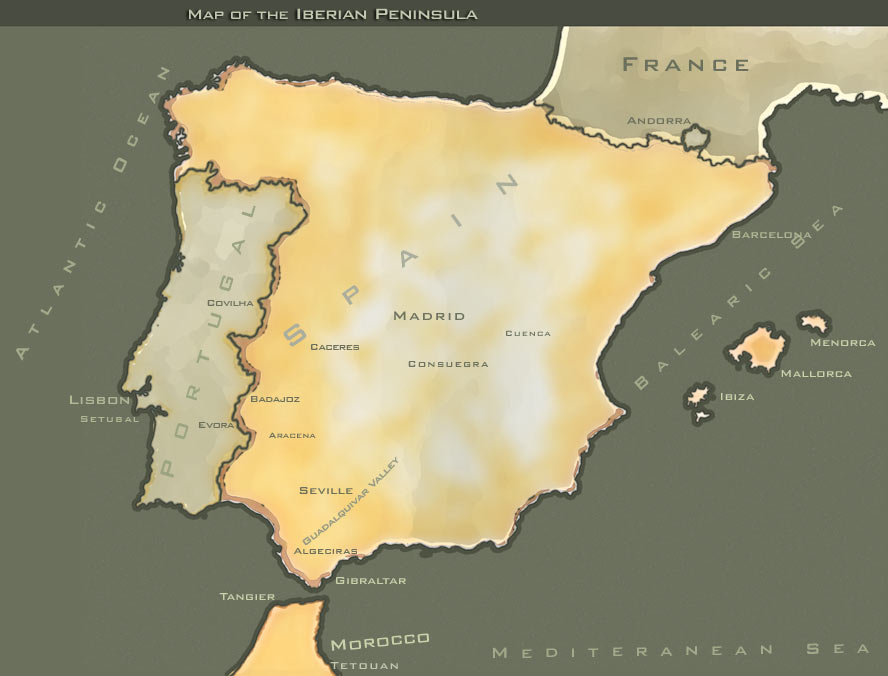 South of France, in Western Europe on the Iberian Peninsula, Spain is surrounded on three sides by water – to the north is the Cantabric Sea, to the west is the Atlantic Ocean, on the east is the Mediterranean Sea. Just across the Straight of Gibraltar lie Morocco and Algeria. A surprise to most is that Spain is the second most mountainous country in Europe behind Switzerland, with a wide variety of climates, from the hot, dry region of Andalucía in the South, to the lush, green and humid zones of Galicia and Asturias in the North and Northwest. In Spain you can ski in Granada one day and go to the beach the next! Spain lies at approximately the same latitude as California, so it has similar weather.
South of France, in Western Europe on the Iberian Peninsula, Spain is surrounded on three sides by water – to the north is the Cantabric Sea, to the west is the Atlantic Ocean, on the east is the Mediterranean Sea. Just across the Straight of Gibraltar lie Morocco and Algeria. A surprise to most is that Spain is the second most mountainous country in Europe behind Switzerland, with a wide variety of climates, from the hot, dry region of Andalucía in the South, to the lush, green and humid zones of Galicia and Asturias in the North and Northwest. In Spain you can ski in Granada one day and go to the beach the next! Spain lies at approximately the same latitude as California, so it has similar weather.
Regional and Cultural Divisions
Spain has been invaded over the centuries by various peoples, including the Phoenicians, the Romans and the Moors. For centuries Spain was divided into small feudal kingdoms that had their own money, culture, languages and food. Although Spain is one country and two basic ingredients common to all regions are garlic and olive oil, there are large regional differences in cuisine. There are traditionally six culinary regions in Spain, however within those regions are areas of distinct cuisinesas well: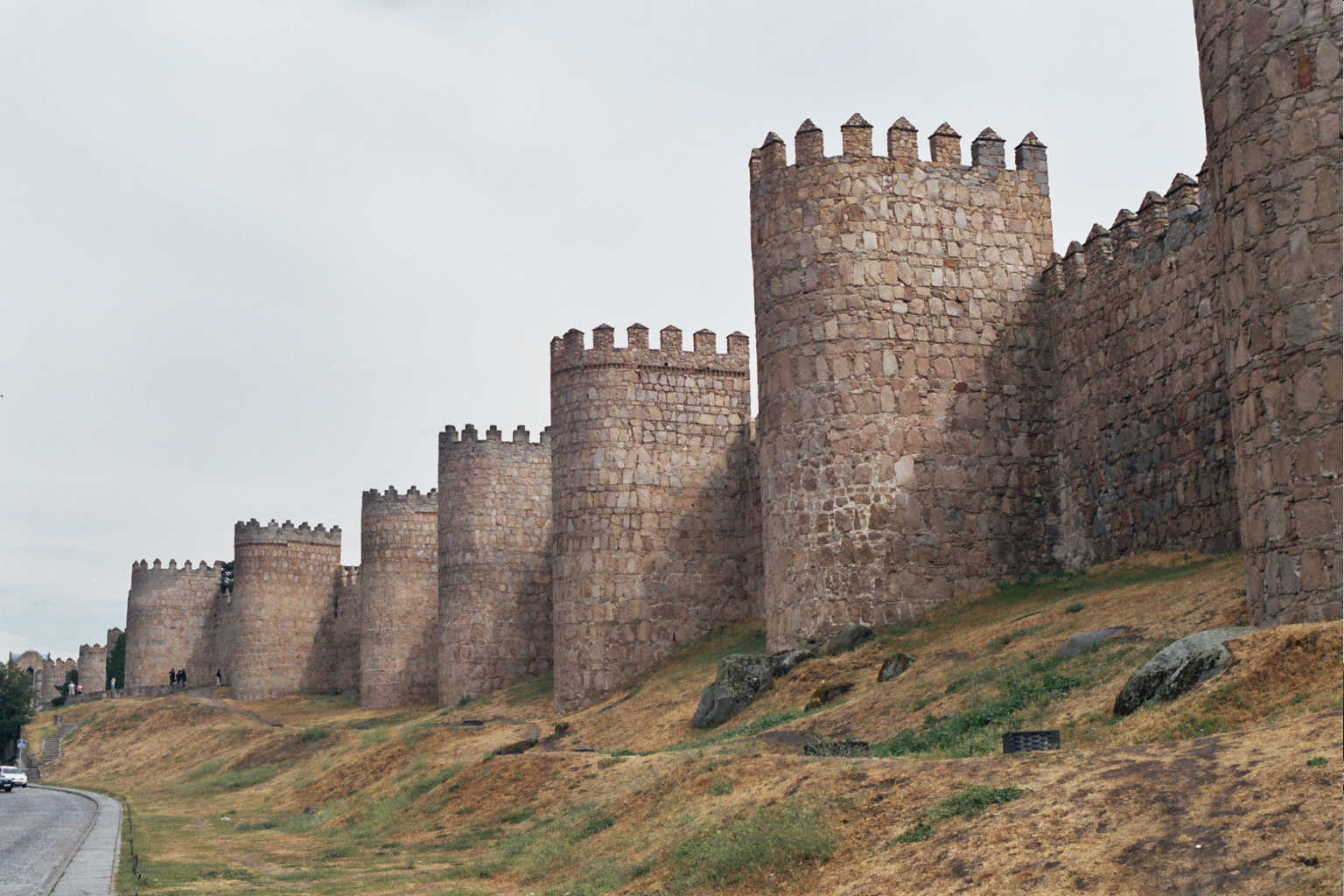
Regional Cuisine of Castilla Leon
Castilla-Leon, the largest area of Spain is known for its roast suckling lamb and pig, as well as hearty stews. Castillians also enjoy fish and seafood plates, and very traditional sweets with a religious past.

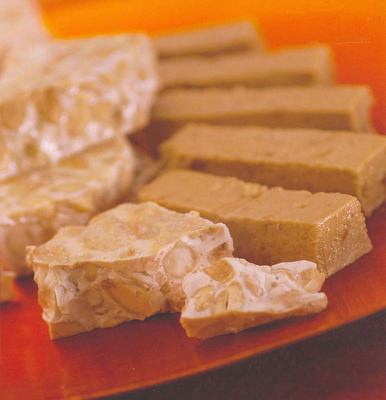 Regional Cuisine of Valencia
Regional Cuisine of Valencia
Valencia is well-known for its rice dishes, in particular "paella." It is also the region where the Spanish almond candy "turron" originates.
 Regional Cuisine of Cataluña
Regional Cuisine of CataluñaCataluña has some of the most sophisticated regional Spanish cuisine. Barcelona has been well known for its cuisine for centuries. Seafood, game, beef or lamb are mixed and cooked with rice and/or sausage. There are a wide variety of dishes in this region.
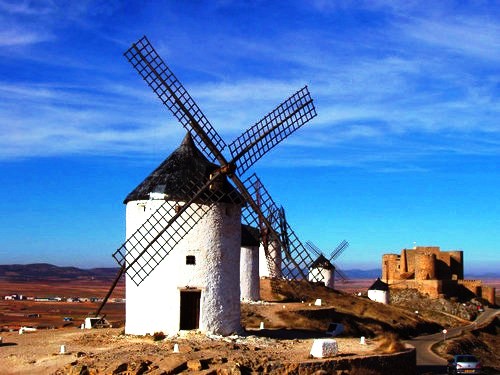
Land of windmills and the stomping ground of Don Quixote, it produces delicious "manchego" cheese, hearty stews and soups and about half of all Spanish wines.
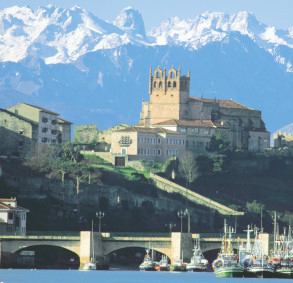 Regional Cuisine of Asturias
Regional Cuisine of Asturias Asturias, a province in the northeastern corner of the Peninsula, with a natural beauty and exquisite cuisine. Regional cuisine from Asturias includes fresh salmon, hot and tasty "Fabada Asturiana" and rich "Cabrales" blue cheese.
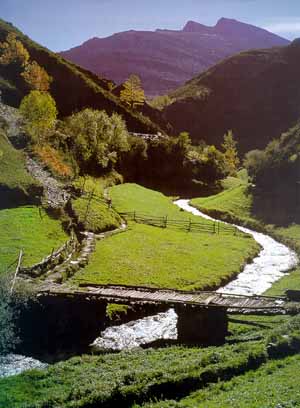
Galicia is located in the extreme northwest of Spain and is known for its fish and seafood, as well as sauces and stews, "empanadas" and fish dishes of Galician cuisine.
Spanish cooking has popular roots. Over the centuries, Spanish cuisine has been influenced by many other cultures, both invaders and visitors, as well as from its colonies. From the Phoenicians, who arrived in the South, and established a colony called Gádir, the modern day Cádiz, to the Romans, who brought not only their government, culture and art, but their agricultural technology, too. Grape-growing and wine-making, olive cultivation and pressing techniques came to the Peninsula. Hispania (the Roman name for the Peninsula) was part of the Roman Empire for over 500 years. During this period, a blending of cuisines took place, with Hispania being an important producer of food for the Empire.
In 711 A.D., the Moors crossed the Straight of Gibraltar from Africa and invaded the Peninsula. They quickly established themselves in South and Central Spain and they flourished for many centuries. The Moors brought with them advanced agricultural technology, rich spices, new fruits and vegetables. In 1492, with the discovery of the New World came revolutionary changes to Spanish cuisine, as well as the rest of Europe. The Spanish explorers brought back many new and exotic foods, such as potatoes, tomatoes, corn, avocados, papayas, peppers and cacao for chocolate.
Spanish cuisine is down-to-earth, uncomplicated food, based on the ingredients available locally or the crops grown regionally. Many dishes are prepared today using the same cooking methods and ingredients as they were two or three hundred years ago.
The Traditional Foods of Spain
 Olive Oil
Olive Oil
Spanish recipes either call for olive oil or lard. Most Spaniards consider extra virgin olive oil to be worth the added expense. Spain is a leading producer of olive oil and olives are grown all over the south of Spain.

Ham
Jamón is a very prized food. Spaniards take their ham very seriously and will pay a high price for top-quality. There is even a denomination of origin for certain types of ham. So proud are Spaniards of their ham, that there are several museums of ham, or museo de jamon. You will see different types on menus or in supermarkets, but typically it will be jamón serrano or ham from the sierra or mountains.
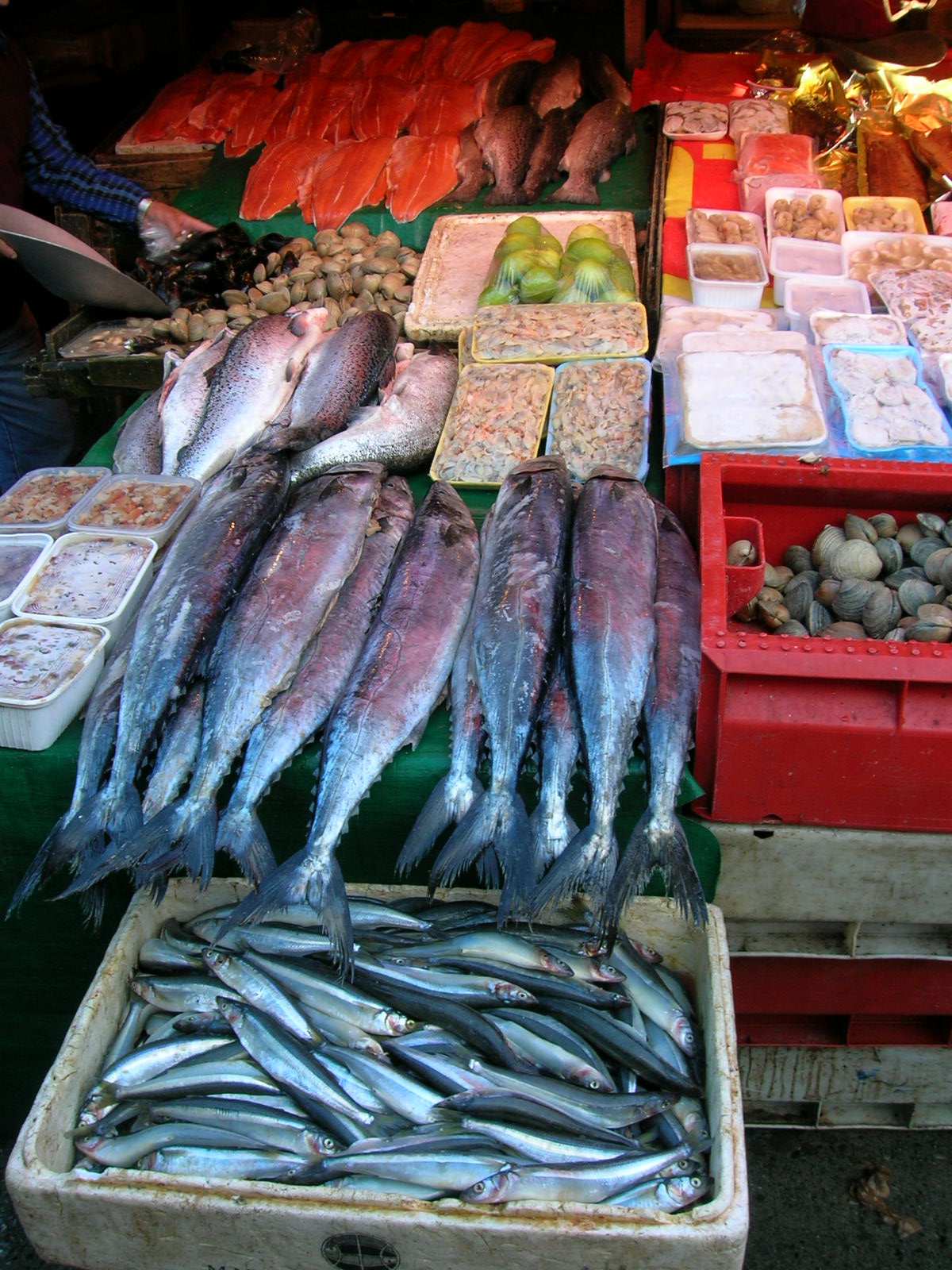 Fish & Seafood
Fish & Seafood
Because Spain is surrounded on three sides by water, fresh seafood is always plentiful in the markets and is eaten daily. Everything from halibut, shrimp, to octopus are common to most markets and menus.
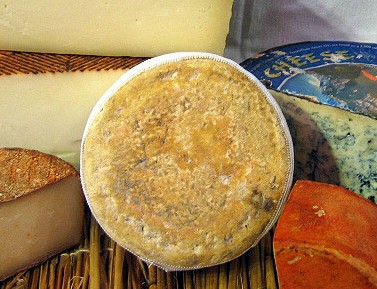 Cheeses
Cheeses
Wonderful cheeses of every type can be eaten in Spain. Spanish cheeses are made from sheep, cow, goat milk and mixed. Types range from aged cheeses, such as the manchego variety from La Mancha, to the soft creamy cheeses such as tetilla from Galicia and everything in between. There are even blue cheeses that mature in limestone caves, such as Cabrales. Cheese can be eaten as a tapa as well as during meals and for dessert. Check out this month's Homage to Fromage for complete coverage of the chesses of Spain.
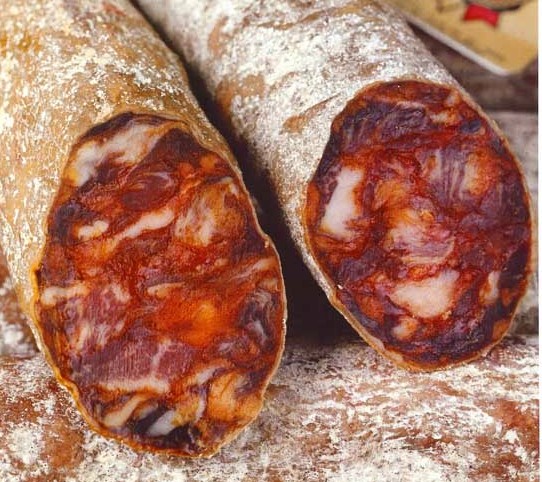 Sausages
Sausages
Spanish love sausage, in particular their chorizo, a pork sausage made with paprika. Again, there are many types of chorizo, from fresh and soft to smoked and aged. Every local market offers a variety and Spanish families often make their own in the winter and hang them in the cellar or the attic to dry.

Beef, Lamb and Pork
All three meats are common and can be roasted, grilled over the coals or sautéed in a sauce. Generally, Spanish prefer veal, suckling lamb and pig. Roasted meats are a popular dish for holidays and festive occasions.
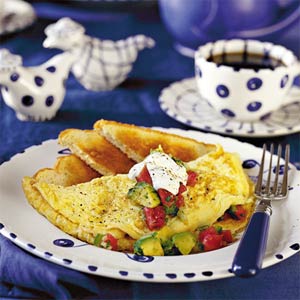
Eggs
Eggs are eaten daily either fried, deviled, or in a Spanish omelet. They are an essential part of many recipes, including desserts.
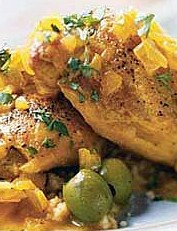
Chicken
Chicken is very popular and is eaten regularly. It is prepared in every way, but mostly commonly is fried, roasted or stewed.

Fruits and Vegetables
Spanish eat lots of fresh fruit as snacks or as the last course to their meals. A fresh fruit bowl sits in every kitchen. Simple salads and sautéed vegetables are eaten every day. Popular dishes often include eggplant and zucchini.
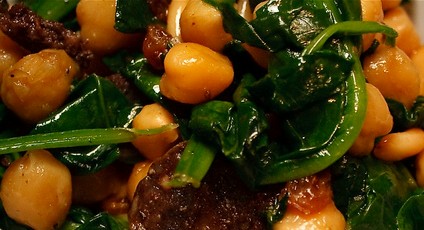
Legumes
Beans of all types are eaten regularly. Beans and chickpeas (garbanzo beans) have been a staple of the Peninsula for centuries and rival bread as the most commonly eaten food.
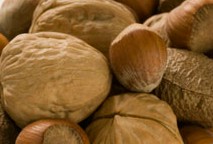 Nuts
Nuts
Spain is one of the top producers of almonds, hazelnuts and walnuts. Almond-based and milk-based desserts are very common. Turron, the almond nougat candy eaten at Christmas is probably the best-known of these sweets. Many recipes of Arabic origin contain crushed almonds. Hazelnuts, not almonds are the most popular nut to be mixed with chocolate.

Herbs and Spices
Onions and herbs such as oregano, rosemary and thyme are used, while garlic is predominant in most regions.
Cooking Methods

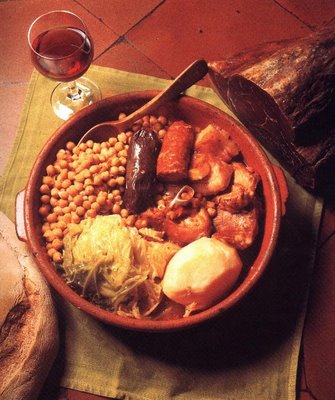 Cocido, olla, pote, guiso, estofado or escudella are the Spanish terms for stew. This is one dish that could be called characteristic of Spain, although each region has its own version. Spanish do not only stew, they roast, fry and saute many foods. It is not as common to bake or broil, although they do grill meats on a metal plate or on a charcoal grill.
Cocido, olla, pote, guiso, estofado or escudella are the Spanish terms for stew. This is one dish that could be called characteristic of Spain, although each region has its own version. Spanish do not only stew, they roast, fry and saute many foods. It is not as common to bake or broil, although they do grill meats on a metal plate or on a charcoal grill.
The typical Spanish working day in any town or city involves a morning's work from about 8:30 or 9 until 1:30, followed by a three hour break in the middle of the day, during which many people go home, have lunch, sleep, watch television, etc., before returning to work at around 4:30. Most people finish work at about 8 P.M., which is about the time that shops close. Spaniards tend to live near their place of work, often in central apartment blocks, and after work, some stay on for a drink or for dinner.
 Breakfast – El Desayuno
Breakfast – El Desayuno
The Smallest Meal of the Day
Continental Breakfast
A typical breakfast might include café con leche - strong coffee with hot, frothy milk, bollos (sweet rolls) with jam, or toast with jam or mild cheese.

Tapas - Little Spanish Meals
Tapas are eaten well after breakfast, but before lunch, the large mid-afternoon meal!
Tapas-time includes bar-hopping to wine-taste and chat
A Different Tapa at each stop
Spanish love tapas so much, they made a verb out of it. The phrase 'Vamos a tapear' means “Let’s go eat tapas!” A few of the most popular tapas are:
Tortilla Española - Spanish Omelet
Patatas Bravas - Potatoes with Spicey Brava Sauce
Gambas al Ajillo - Shrimp in Garlic
La Comida – Lunch
 The midday meal, la comida as it is called in Spain is the largest meal of the day. It is definitely a large meal, usually with multiple courses. Traditionally, Spaniards have a 2-3 hour break from work or school in order to enjoy la comida and take a nap or siesta and the entire country closes up shop from about 2:00 P.M. to 5:00 P.M. The siesta is a tradition that goes back centuries. When most people worked in agriculture and air conditioning did not exist, it is easy to understand why folks needed a large meal and a rest from the hot Spanish sun before returning to work outside. Everyone in Spain enjoyed this afternoon break, from school kids to shop workers and government officials. Most Spanish still enjoy the break and large meal, but life is slowly changing. Many people spend over an hour commuting to and from their work, making it impossible to go home for a meal and siesta. Because of this, Spanish government employees in Madrid now work a standard eight-hour day with a one-hour lunch break. Many large supermarket and retail chains in large cities no longer close for
The midday meal, la comida as it is called in Spain is the largest meal of the day. It is definitely a large meal, usually with multiple courses. Traditionally, Spaniards have a 2-3 hour break from work or school in order to enjoy la comida and take a nap or siesta and the entire country closes up shop from about 2:00 P.M. to 5:00 P.M. The siesta is a tradition that goes back centuries. When most people worked in agriculture and air conditioning did not exist, it is easy to understand why folks needed a large meal and a rest from the hot Spanish sun before returning to work outside. Everyone in Spain enjoyed this afternoon break, from school kids to shop workers and government officials. Most Spanish still enjoy the break and large meal, but life is slowly changing. Many people spend over an hour commuting to and from their work, making it impossible to go home for a meal and siesta. Because of this, Spanish government employees in Madrid now work a standard eight-hour day with a one-hour lunch break. Many large supermarket and retail chains in large cities no longer close for 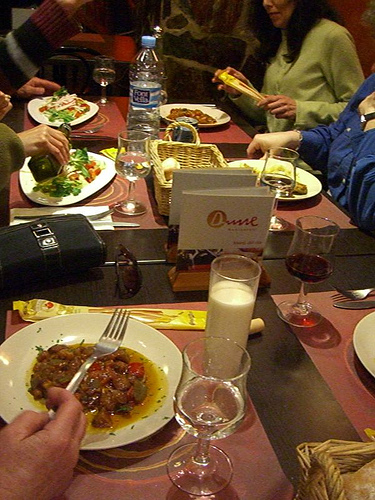 lunch either. Still, in most of the country folks close up shop and enjoy their meal and break.
lunch either. Still, in most of the country folks close up shop and enjoy their meal and break.
The Largest Meal of the Day
Multiple Courses
Eaten between 1:30 and 3:30 P.M.
Below is a sample meal that you might find on a menu at a restaurant or if you were invited to someone’s home for lunch:
Vegetable or Seafood Soup
Fresh Fish or Seafood, Roast Chicken or Lamb, Fried Potatoes, Rabbit Stew, etc.
Green Salad or Vegetables
Dessert - Flan, light pastry, fresh fruit or ice cream
Coffee, Brandy and a Cigar
Bread is ALWAYS on the Spanish table. It is plentiful and fresh and used to mop up sauces. Spanish lunches are always large! Courses come one at a time, so pace yourself!
Since Spaniards love eggs and dairy foods, you will find that many desserts are made from fresh milk or cream. Fresh fruit is typical to see on the dessert menu, and may be served with a soft cheese. Don’t forget the coffee – You’ll probably need that after the big lunch!
La Merienda - Snack
 The late-afternoon snack in Spain is called la merienda and is necessary since lunch is done by 3:30 P.M., but dinner isn't usually eaten for another five to six hours. La Merienda is especially important to children, who always seem to have lots of energy and play soccer in the streets, etc. La Merienda can be anything from a piece of French-style bread with a piece of chocolate on top, to bread with chorizo, ham or salami. La Merienda is eaten around 4:30 or 5:00 P.M..
The late-afternoon snack in Spain is called la merienda and is necessary since lunch is done by 3:30 P.M., but dinner isn't usually eaten for another five to six hours. La Merienda is especially important to children, who always seem to have lots of energy and play soccer in the streets, etc. La Merienda can be anything from a piece of French-style bread with a piece of chocolate on top, to bread with chorizo, ham or salami. La Merienda is eaten around 4:30 or 5:00 P.M..
La Cena – Dinner
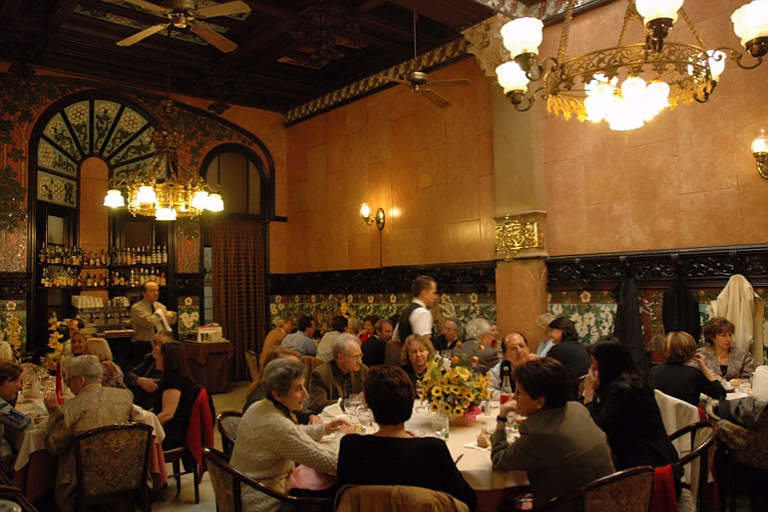 Smaller than Lunch
Smaller than Lunch
Eaten between 9:00 P.M. and Midnight
A dinner might include fresh fish or seafood, roast chicken or lamb, fried potatoes or rice. A simple and quick dish, commonly eaten at dinner is arroz cubano, which is a mound of white rice, topped with tomato sauce and a fried egg. Green salad and/or a vegetable dish are standard at lunch and dinner. A lighter dessert of fresh fruit or flan (Spanish vanilla custard) may also be eaten.
After Dinner
Spaniards are night owls. The typical Spaniard does not eat dinner until at least 9 P.M. and probably does not get to bed until close to midnight. On the weekends, on holidays and during the summer months, it wouldn’t be unusual for a Spanish family to turn in round 3 or 4 am. So, after the late-night dinner, Spaniards continue their socializing in their neighborhood cafés and taverns or go out to a nightclub or disco-pub.

The last stop on the way home from an evening of fun might be to a churreria or a churro stand. After a night on the town, there is nothing better than  fresh churros, bought from a street vendor or sidewalk café, served hot and sprinkled with sugar.They are delicious and very light.
fresh churros, bought from a street vendor or sidewalk café, served hot and sprinkled with sugar.They are delicious and very light.
To accompany your churros, hot chocolate is the drink of choice. Chocolate in Spain is your typical rich drinking chocolate that is common throughout Europe, although Spanish chocolate is hot and very thick, made with fresh, whole milk. It’s very sweet and sometimes so thick that you can stand a spoon in it.
***
So there you have a pretty comprehensive snapshot of Spain, it's regions and it's cuisines. The most fascinating aspect of all this for me, being a traditionalist at heart, is that even though we now find ourselves in 2009, many of the centuries old traditions and dishes are still popular among the younger Spanish generations, having been handed down within each family. This is certainly a culture that has embraced the overall integration of dining together as much more than just eating. To the Spaniard, it has always been, and continues to be, the center of social interaction.
Ah...what a life! A little tapas, a nice nap. You know, I could get used to this.
Image Sources
allworld-vacation.com, wikipedia.org, a-t-s.net, viajejet.com, afectadosporbanif.ning.com, seelecttea.com, t3.gstatic.com, delariberanavarra.com, freecountry.bligoo.com, livespanish.com, robinyap.com


